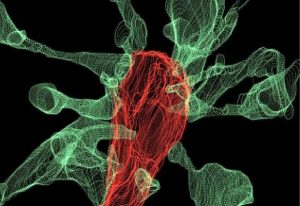Microglia prune synapses to remodel brain circuits. (6 min)
Kevin's new online seminar on Long-Term Learning. (1 min)
Teaching A&P tells the story of the human body. (15 min)
If you cannot see or activate the audio player click here.
Follow The A&P Professor on Twitter, Facebook, Blogger, Nuzzel, Tumblr, or Instagram!

Multiple synapse heads send out filopodia (green)
converging on one microglial cell (red),
as seen by focused ion beam scanning
electron microscopy (FIBSEM).
IMAGE: L. Weinhard, EMBL Rome
- Microglia remodel synapses by presynaptic trogocytosis and spine head filopodia induction (original research report)
- Captured: microglia nibbling on brain synapses (article about the original report)
- Neurophobia: The Fear of Neurology Among Medical Students (the title says it all)
- Long Term Learning (the new seminar)
- Educational Uses of Digital Storytelling (website with many resources)
- Crash Course in Storytelling (book on the basics of storytelling)
- Long Story Short: The Only Storytelling Guide You'll Ever Need (book; the title says it all)
- More details at the episode page.
- Transcript available at the script page.
- Listen to any episode on your Alexa device.
Click here to listen to this episode—or access the detailed notes and transcript.


No comments:
Post a Comment